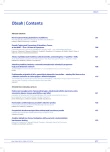Acute Myeloblastic Leukaemia with Alternationsof MLL Proto-Oncogene Protein (11q23/ MLL+ AML)
Authors:
Z. Mikulášová 1; D. Ilenčíková 1,2; T. Slamka 1; D. Ďurovčíková 2
Authors‘ workplace:
Oddelenie onkologickej genetiky, Národný onkologický ústav, Bratislava, Slovenská republika
1; Katedra lekárskej genetiky SZU‑ FZŠŠ, Bratislava, Slovenská republika
2
Published in:
Klin Onkol 2010; 23(6): 401-407
Category:
Reviews
Overview
One of the most common chromosomal breakpoint regions in acute myeloid leukaemia is the chromosome band 11q23. The analysis of this region led to the discovery of the extremely promiscuous MLL gene, in which more than 60 MLL translocation partner genes have been described. Among the most frequent are t(9;11)(p21– 22;q23)/ MLL‑ AF9, t(10;11)(p13;q23)/ MLL‑ AF10, t(11;19)(q23;p13)/ MLL‑ ELL, ENL and t(6;11)(q27;q23)/ MLL‑ AF6. The presented work provides an overview of the molecular mechanisms by means of which MLL proto‑ oncogene can be converted into oncogene. Genetic alternations of the MLL Proto-Oncogene Protein besides translocation are also represented by complex chromosomal rearrangements, deletions, insertions, partial tandem duplications, amplifications and gains. These genetic alterations are described in the work from the diagnostic and prognostic point of view. Abnormalities of the MLL Proto-Oncogene Protein are usually connected with bad prognosis. For that reason, in oncological practice, particular attention is paid to introducing new genetic methods for their identification. The above work gives well arranged information about different types of genetic tests and their outcomes, which can help oncologists in predicting the prognosis, in minimal residual disease monitoring and in modifying oncological patient treatment.
Key words:
acute myeloid leukaemia – MLL Proto-Oncogene Protein – chromosomal translocations
Sources
1. Jabbour EJ, Estey E, Kantarjian HM et al. Adult Acute Myeloid Leukemia. Mayo Clin Proc 2006; 81(2): 247– 260.
2. Pedersen‑ Bjergaard J, Christiansen DH, Andersen MK et al. Causality of myelodysplasia and acute myeloid leukemia and their genetic abnormalities. Leukemia 2002; 16(11): 2177– 2184.
3. Schoch C, Schnittger S, Klaus M et al. AML with 11q23/ MLL abnormalities as defined by the WHO classification: incidence, partner chromosomes, FAB subtype, age distribution, and prognostic impact in an unselected series of 1897 cytogenetically analyzed AML cases. Blood 2003; 102(7): 2395– 2402.
4. Haferlach T, Schoch C, Schnittger S et al. Distinct genetic patterns can be identified in acute monoblastic and acute monocytic leukaemia (FAB AML M5a and M5b): a study of 124 patients. Br J Haematol 2002; 118(2): 426– 431.
5. Arnaud B, Douet‑ Guilbert N, Morel F et al. Screening by fluorescent in situ hybridization for MLL status at diagnosis in 239 unselected patients with acute myeloblastic leukemia. Cancer Genet Cytogenet 2005; 161(2): 110– 115.
6. Cox MC, Panetta P, Lo‑ Coco F et al. Chromosomal Aberration of the 11q23 Locus in Acute Leukemia and Frequency of MLL Gene Translocation: results in 378 adult patients. Am J Clin Pathol 2004; 122(2): 298– 306.
7. Alcalay M, Meani N, Gelmetti V et al. Acute myeloid leukemia fusion proteins deregulate genes involved in stem cell maintenance and DNA repair. J Clin Invest 2003; 112(11): 1751– 1761.
8. Armstrong SA, Staunton JE, Silverman LB et al. MLL translocations specify a distinct gene expression profile that distinguishes a unique leukemia. Nat Genet 2002; 30(1): 41– 47.
9. Cimino G, Rapanotti MC, Sprovieri T et al. All1 gene alternations in Acute leukemia: biological and clinical aspects. Haematologica 1998; 83(4): 350– 357.
10. Wakui M, Kuriyama K, Miyazaki Y et al. Diagnosis of acute myeloid leukemia according to the WHO classification in the Japan Adult Leukemia Study Group AML‑97 protocol. Int J Hematol 2008; 87(2): 144– 151.
11. Broeker PL, Super HG, Thirman MJ et al. Distribution of 11q23 breakpoints within the MLL breakpoint cluster region in de novo acute leukemia and in treatment‑related acute myeloid leukemia: correlation with scaffold attachment regions and topoisomerase II consensus binding sites. Blood 1996; 87(5): 1912– 1922.
12. Giampaolo A, Felli N, Diverio D et al. Expression pattern of HOXB6 homeobox gene in myelomonocytic differentiation and acute myeloid leukemia. Leukemia 2002; 16(7): 1293– 1301.
13. Meyer C, Kowarz E, Hofmann J et al. New insights to the MLL recombinome of acute leukemias. Leukemia 2009; 23(8): 1490– 1499.
14. Ayton PM, Cleary ML. Molecular mechanisms of leukemogenesis mediated by MLL fusion proteins. Oncogene 2001; 20(40): 5695– 5707.
15. Whitman SP, Liu S, Vukosavljevic T et al. The MLL partial tandem duplication: evidence for recessive gain‑of‑ function in acute myeloid leukemia identifies a novel patient subgroup for molecular‑ targeted therapy. Blood 2005; 106(1): 345– 352.
16. Libura M, Asnafi V, Tu A et al. FLT3 and MLL intragenic abnormalities in AMLreflect a common category of genotoxic stress. Blood 2003; 102(6): 2198– 2204.
17. Caligiuri MA, Strout M, Lawrence D et al. Rearrangement of ALL1 (MLL) in acute myeloid leukemia with normal cytogenetics. Cancer Res 1998; 58(1): 55– 59.
18. Schnittger S, Kinkelin U, Schoch C et al. Screening for MLL tandem duplication in 387 unselected patients with AML identify a prognostically unfavorable subset of AML. Leukemia 2000; 14(5): 796– 804.
19. Tanaka K, Takechi M, Nishimura S. et al. Amplification of the c‑ MYC oncogene and point mutation of N‑ RAS oncogene in acute myelocytic leukemia with double minute chromosomes. Leukemia 1993; 7(3): 469– 473.
20. Andersson A, Höglund M, Johansson B et al. Paired multiplex reverse‑ transcriptase polymerase chain reaction (PMRT‑PCR) analysis as a rapid and accurate diagnostic tool for the detection of MLL fusion genes in hematologic malignancies. Leukemia 2001; 15(8): 1293– 1300.
21. Rego EM. Molecular basis of Acute myelogenous Leukemia. Rev bras hematol hemoter 2002; 24(3): 163.
22. Gene Cards. The Human Gene Compendium. MLL Gene. Dostupné z http://www.genecards.org/cgi-bin/carddisp.pl?gene=MLL&search=MLL.
Labels
Paediatric clinical oncology Surgery Clinical oncologyArticle was published in
Clinical Oncology

2010 Issue 6
Most read in this issue
- New Therapeutic Options in Therapy of Glioblastoma Multiforme
- Hormonal Contraceptives and Their Relationship to Breast Cancer
- Acute Myeloblastic Leukaemia with Alternationsof MLL Proto-Oncogene Protein (11q23/ MLL+ AML)
- Postoperative Accelerated Partial Radiotherapy for Breast Cancer
